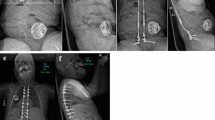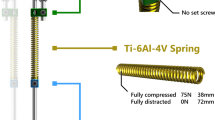Abstract
Study design
Multicenter retrospective review.
Objectives
To compare the radiographic outcomes and complication rates in patients with primary and conversion magnetically controlled growing rod (MCGR) implants at one and two years after surgery.
Summary of background data
Many initial early-onset scoliosis (MCGR) implantations in the United States were conversions from other types of growth-friendly systems, and the outcome similarities and differences between primary and conversion MCGR implantation procedures are still relatively unknown.
Methods
Multicenter retrospective review of EOS patients from two multicenter EOS registries identified consecutive EOS patients treated from 2014 to 2017 with a minimum of one-year follow-up. In addition, a subset of these patients who had two-year follow-up were further analyzed.
Results
In total, 383 MCGR patients were identified, of which 272 (71%) were primary (P) and 111 (29%) were conversion (C). Group P patients had significantly greater coronal curves at the time of MCGR implantation and greater initial coronal correction. There was no statistically significant difference in Cobb correction at one year or between follow-up at one and two years. The preimplantation thoracic spine height was identical in both groups, with statistically greater improvement at initial implantation in P than in C patients. Significantly greater height gains were seen in P than in C patients in the one-year follow-up cohort. There was a higher rate of complications in the C group than in the P group; however, the difference was not statistically significant. Overall, most complications were implant-related. No loss of curve correction occurred in either group.
Conclusions
Patients with primary MCGR insertion can be expected to have greater radiographic correction and spine length gain than those with conversion from growth-friendly instrumentation to MCGR, most likely because of increased spine stiffness in conversion patients. The rate of complications, primarily implant-related, remains higher in conversion than in primary insertion patients.
Level of Evidence
Level III.
Similar content being viewed by others
References
Karol LA. Early definitive spinal fusion in young children: what we have learned. Clin Orthop Relat Res 2011;469:1323–9.
Karol LA, Johnston C, Mladenov K, et al. Pulmonary function following early thoracic fusion in non-neuromuscular scoliosis. J Bone Joint Surg Am 2008;90:1272–81.
Cheung KM, Cheung JP, Samartzis D, et al. Magnetically controlled growing rods for severe spinal curvature in young children: a prospective case series. Lancet 2012;379:1967–74.
Matsumoto H, Williams BA, Corona J, et al. Psychosocial effects of repetitive surgeries in children with early-onset scoliosis: are we putting them at risk? J Pediatr Orthop 2014;34: 172–8.
Flynn JM, Matsumoto H, Torres F, et al. Psychological dysfunction in children who require repetitive surgery for early onset scoliosis. J Pediatr Orthop 2012;32:594–9.
Wong CKH, Cheung JPY, Cheung PWH, et al. Traditional growing rod versus magnetically controlled growing rod for treatment of early onset scoliosis: cost analysis from implantation till skeletal maturity. J Orthop Surg 2017;25. 230949901770502.
Cobanoglu M, Shah SA, Gabos P, et al. Comparison of intended lengthening of magnetically controlled growing rods: ultrasound versus X-ray. J Pediatr Orthop 2019;39:e141–6.
Charroin C, Abelin-Genevois K, Cunin V, et al. Direct costs associated with the management of progressive early onset scoliosis: estimations based on gold standard technique or with magnetically controlled growing rods. Orthop Traumatol Surg Res 2014; 100: 469–74.
Keskinen H, Helenius I, Nnadi C, et al. Preliminary comparison of primary and conversion surgery with magnetically controlled growing rods in children with early onset scoliosis. Eur Spine J 2016;25:3294–300.
Kwan KYH, Alanay A, Yazici M, et al. Unplanned reoperations in magnetically controlled growing rod surgery for early onset scoliosis with a minimum of two-year follow-up. Spine (Phila Pa 1976) 2017;42:E1410–4.
Teoh KH, Winson DMG, James SH, et al. Do magnetic growing rods have lower complication rates compared with conventional growing rods? Spine J 2016;16:S40–4.
Smith JT, Johnston C, Skaggs D, et al. A new classification system to report complications in growing spine surgery: a multicenter consensus study. J Pediatr Orthop 2015;35:798–803.
Sankar WN, Skaggs DL, Yazici M, et al. Lengthening of dual growing rods and the law of diminishing returns. Spine (Phila Pa 1976) 2011;36:806–9.
Sawyer JR, de Mendonca RG, Flynn TS, et al. Complications and radiographic outcomes of posterior spinal fusion and observation in patients who have undergone distraction-based treatment for early onset scoliosis. Spine Deform 2016;4:407–12.
Jain A, Sponseller PD, Flynn JM, et al. Avoidance of “final” surgical fusion after growing-rod treatment for early-onset scoliosis. J Bone Joint Surg Am 2016;98:1073–8.
El-Hawary R, Samdani A, Wade J, et al. Rib-based distraction surgery maintains total spine growth. J Pediatr Orthop 2016;36: 841–6.
Akbarnia BA, Pawelek JB, Cheung KMC, et al. Traditional growing rods versus magnetically controlled growing rods for the surgical treatment of early-onset scoliosis: a case-matched 2-year study. Spine Deform 2014;2:493–7.
Astur N, Flynn JM, Flynn JM, et al. The efficacy of rib-based distraction with VEPTR in the treatment of early-onset scoliosis in patients with arthrogryposis. J Pediatr Orthop 2014;34:8–13.
Gardner A, Beaven A, Marks D, et al. Does the law of diminishing returns apply to the lengthening of the MCGR rod in early onset scoliosis with reference to growth velocity? J Spine Surg 2017;3: 525–30.
Spurway AJ, Hurry JK, Gauthier L, et al. Three-dimensional true spine length: a novel technique for assessing the outcomes of scoliosis surgery. J Pediatr Orthop 2017;37:e631–7.
Spurway AJ, Chukwunyerenwa CK, Kishta WE, et al. Sagittal spine length measurement: a novel technique to assess growth of the spine. Spine Deform 2016;4:331–7.
Choi E, Yaszay B, Mundis G, et al. Implant complications after magnetically controlled growing rods for early onset scoliosis: a multicenter retrospective review. J Pediatr Orthop 2017;37: e588–92.
Dannawi Z, Altaf F, Harshavardhana NS, et al. Early results of a remotely-operated magnetic growth rod in early-onset scoliosis. Bone Joint J 2013;95-B:75–80.
Hickey BA, Towriss C, Baxter G, et al. Early experience of MAGEC magnetic growing rods in the treatment of early onset scoliosis. Eur Spine J 2014;23(suppl l):S61–5.
Lebon J, Batailler C, Wargny M, et al. Magnetically controlled growing rod in early onset scoliosis: a 30-case multicenter study. Eur Spine J 2017;26:1567–76.
Ridderbusch K, Rupprecht M, Kunkel P, et al. Preliminary results of magnetically controlled growing rods for early onset scoliosis. J Pediatr Orthop 2017;37:e575–80.
Thompson W, Thakar C, Rolton DJ, et al. The use of magnetically-controlled growing rods to treat children with early-onset scoliosis: early radiological results in 19 children. Bone Joint J 2016;98-B:1240–7.
Park HY, Matsumoto H, Feinberg H, et al. The classification for early-onset scoliosis (C-EOS) correlated with the speed of vertical expandable prosthetic titanium rib (VEPTR) proximal anchor failure. J Pediatr Orthop 2017;37:381–6.
Author information
Authors and Affiliations
Corresponding author
Additional information
Author disclosures: CWH (none), MGV (personal fees and other from Biomet, personal fees from Stryker, outside the submitted work), AS (personal fees from DePuy, Ethicon, Globus Medical, Misonix, Stryker, and Zimmer Biomet, outside the submitted work), HM (none), JTS (personal fees from Biomet, DePuy, Ellipse Technologies, Globus Medical, and Spineguard, outside the submitted work), PFS (personal fees from DePuy, Medtronic Sofamor Danek, and NuVasive, outside the submitted work), PDS (personal fees from Biomet; personal fees and other from DePuy; personal fees from Globus Medical, outside the submitted work), SJL (personal fees from DePuy, Globus Medical, Medtronic Sofamor Danek, and Stryker, outside the submitted work), TSH (none), REH (personal fees and other from DePuy; other from Joint Solutions; personal fees and other from Medtronic; personal fees from Apifix, Wishbone Medical, and Springer, outside the submitted work), JRS (personal fees from DePuy, NuVasive, Elsevier Publishing, and Wolters-Kluwer, during the conduct of the study).
Funding: No funding was received in support of this study.
IRB approval: IRB approval was not required.
Rights and permissions
About this article
Cite this article
Hung, C.W., Vitale, M.G., Samdani, A. et al. Outcomes of Primary and Conversion Magnetically Controlled Growth Rods Are Different at Two-Year Follow-up: Results of North American Release. Spine Deform 7, 829–835 (2019). https://doi.org/10.1016/j.jspd.2019.01.002
Received:
Revised:
Accepted:
Published:
Issue Date:
DOI: https://doi.org/10.1016/j.jspd.2019.01.002




